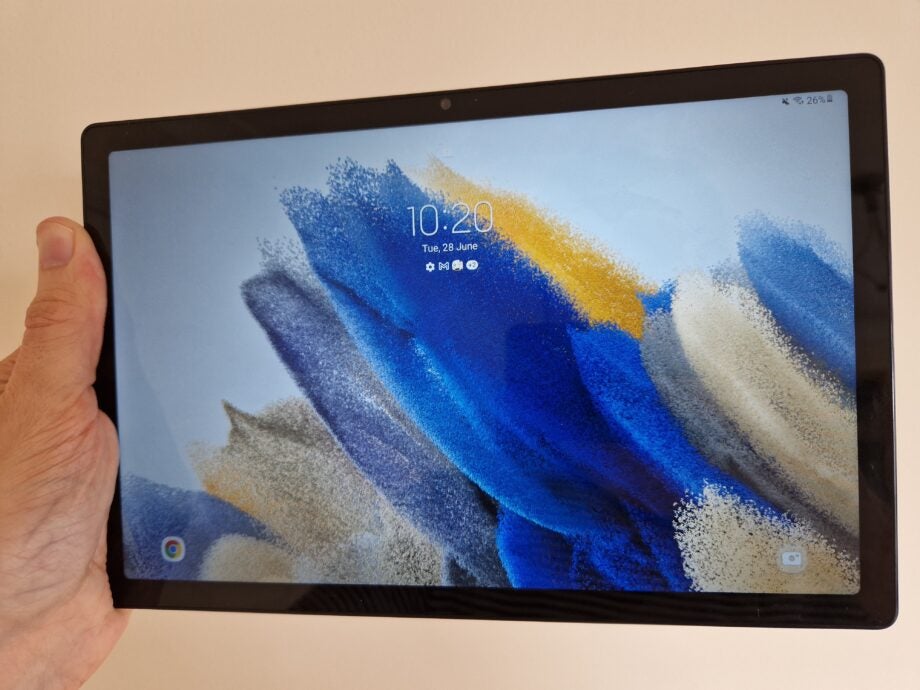The Galaxy Tab A8 is an affordable tablet that’s got a decent screen and reliable battery life. However during our tests we found the performance levels are very underwhelming, the camera isn’t great, and it takes a while to charge back up. This makes it a mediocre option in today’s tablet market.
Pros
- Nice design
- Good battery life
- Decent screen
Cons
- Poor performance
- Mediocre cameras
- Slow charging
- 10.5-inch screenThis tablet has a large screen for watching videos or playing games
- 7040mAh batteryWith a considerable battery capacity, you should be able to use this tablet on the go for longer
- Front and rear camerasIf you need your tablet for video calls or taking the occasional snap, it’s got a 5-megapixel front-facing lens and an 8-megapixel rear sensor
Introduction
The Galaxy Tab A8 is Samsung’s pitch to the budget end of the tablet market – a far cry from the luxury of all-singing, all-dancing Galaxy Tab S8 Ultra.
If you splash out on this device, you’ll get a 10.2-inch screen with a large 7040mAh battery for an affordable price – but does it perform its key functions well, or does it amount to less than the sum of its parts?
Design and Screen
- Attractive, unflashy design
- No IP rating
- Picked up some scuffs, but feels robust
In keeping with most tablets on the market, the Galaxy Tab A8 is not a flashy device in terms of its colour or design. Our review sample has a dark grey rear panel, and the only hint of any flair is a slightly lighter-toned stripe running along one edge. Other than that and the camera lens, it just appears as a large grey slate. Most crucially, it has a matte rather than glossy finish on this back panel, so that it doesn’t act as a magnet for fingerprints and smears.
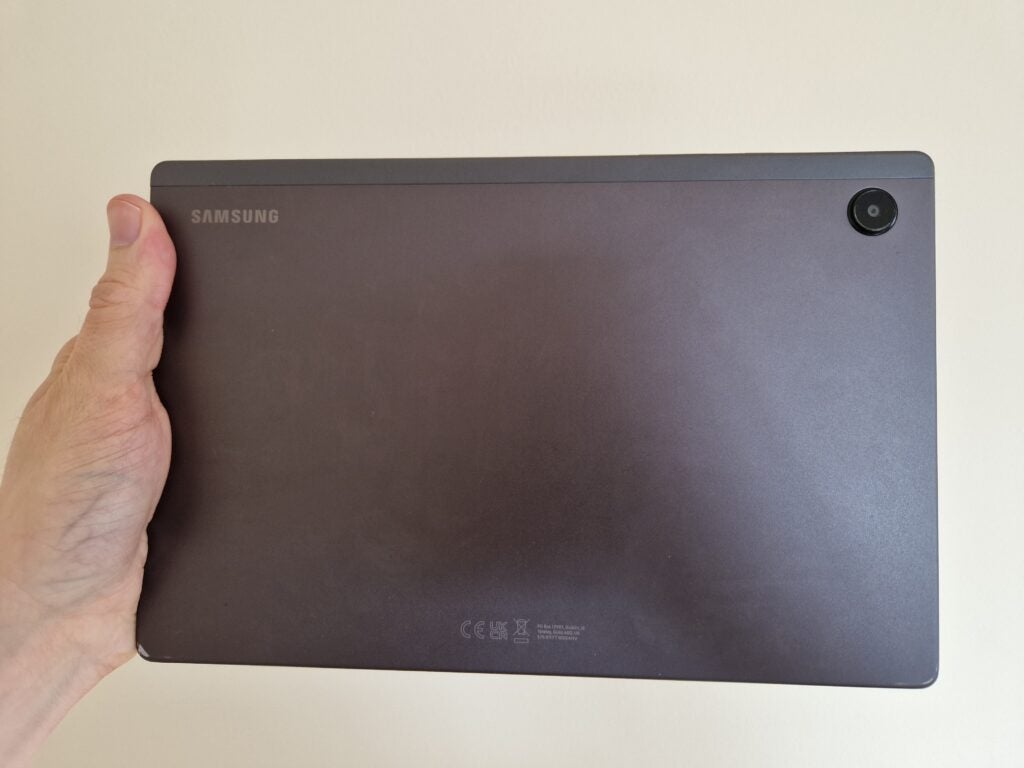
However, while it’s a growing trend for big-screen devices to cut down on the bezels around the side of the screen, this one still has rather significant black bars at the edges, and though they are at least uniform in size (unlike the iPad 9), it would look more appealing with a minimal frame around the edges. Having said that, we have at least been spared the unsightly in-display notch that was unfortunately present on the brand’s flagship tablet, the Galaxy Tab S8 Ultra.
The tablet still retains the 3.5mm headphone jack for wired audio playback that has long since been dropped by many premium smartphones, including Samsung’s own Galaxy S22 series, and it’s got a dedicated MicroSD card slot too if you need to expand the storage or transfer photos from your camera more easily. This latter feature may prove especially useful given that, of the base-level 32GB storage, only 18.2GB is actually available to use after system requirements and pre-installed apps are taken care of.
When it comes to unlocking the tablet, you’ve got the options of using a PIN, a pattern, or face unlock. All of these methods worked responsively for me, without irritatingly long delays or false negatives. The tablet also did a fairly decent enough job of reorientating itself when moved from a landscape position to portrait and vice versa, although this could be choppy and did sometimes leave me waiting an extra few second for the right orientation.
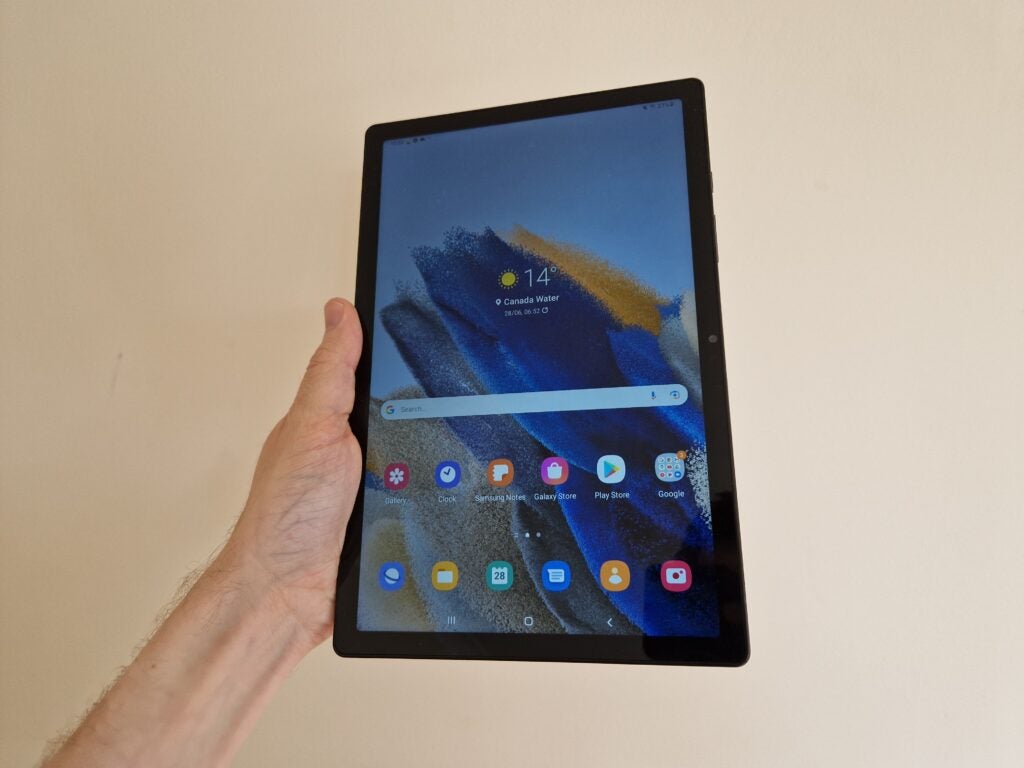
Unfortunately, the Galaxy Tab A8 doesn’t have an IP rating, so we can’t be exactly sure of how it would manage with exposure to water or dust. What’s more, the manufacturer has not stated whether the display is made of Gorilla Glass or a similarly scratch-resistant material. However, the frame still felt physically robust and did not flex under duress, so I don’t think you’ll need to worry about your child breaking the device unless a very large amount of force is exerted.
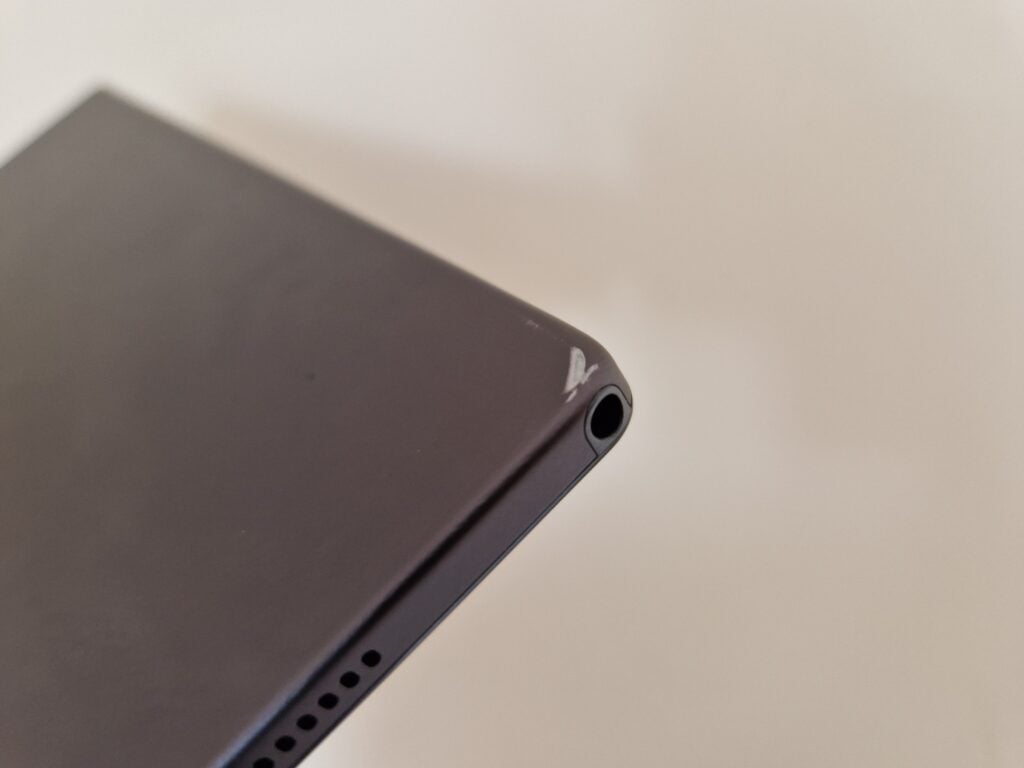
Nonetheless, if you’re buying this I’d still recommend getting a case for a few reasons. Firstly I did notice a couple of scuffs on one of the corners after my week with it (see above), which could otherwise have been avoided. Secondly, it does have a large screen that could be vulnerable to scratching if it’s not covered up. Thirdly, a case with a built-in support would allow you to prop this 508g device up on a table or your lab without you needing to hold it yourself for the duration of a film, for example.
Screen
- Good-sized screen
- LCD rather than OLED
- Good for watching films or TV shows
The screen measures 10.2-inches, and I found this to be a fairly good size for watching films and TV series when it’s propped up in front of you, and when it’s lying flat on a table top it’s also a good size for reading through articles or webpages without you having to move it closer to your face.
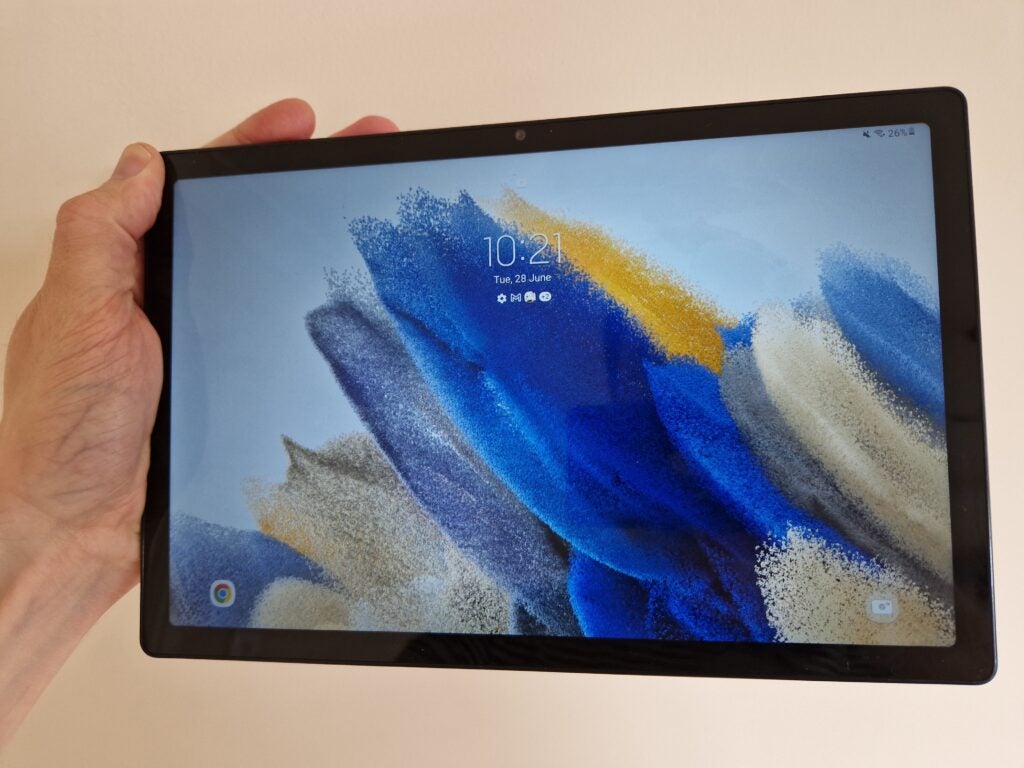
The display is LCD rather than OLED, which means that the contrast isn’t perfect and you’ll miss out those majestic deep blacks that characterise OLEDs. Samsung is usually a champion of OLED screens, even on its budget smartphones, so it’s a bit of shame that it hasn’t brought that expertise to bear on this device. The display supports over 16 million colours, which is a good level of colour depth, and the resolution is 1200 x 1920p.
While this quality would be very good for a smartphone of the same price, you are more aware of its shortcomings on a larger-screened tablet as it’s not as super-sharp as you might be used to when watching the same content on a high quality living room TV, for instance.
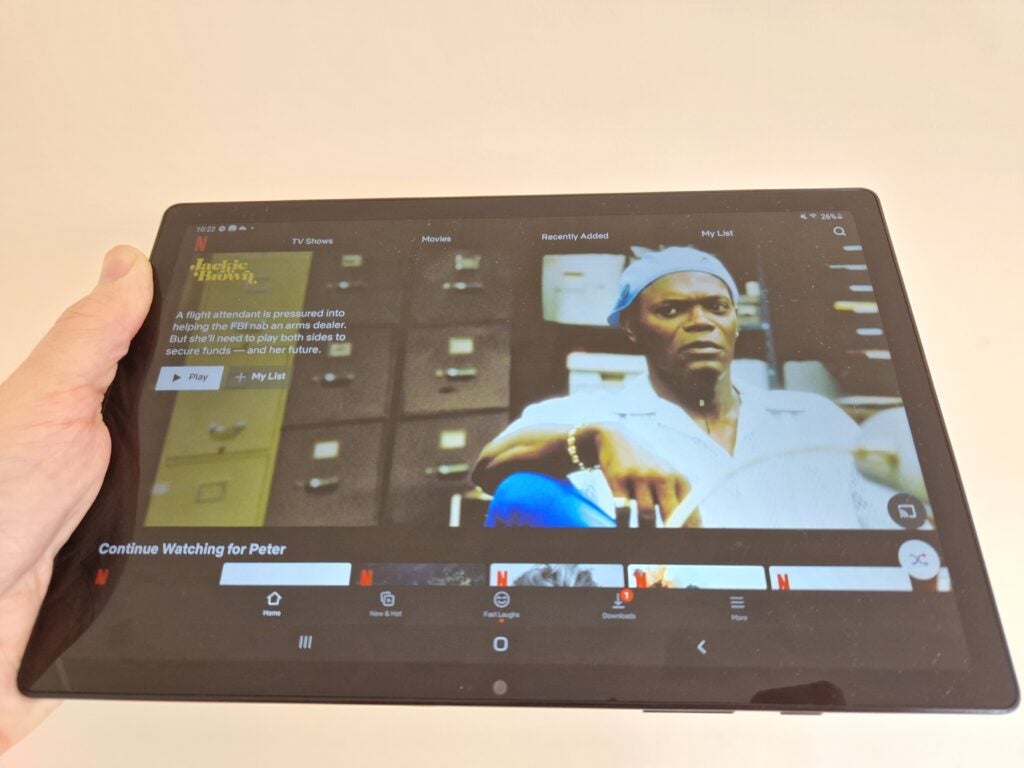
I spent hours using this device to watch films and TV shows, and though the screen is not the very best around it is still high enough quality to enjoy what you’re watching. Whether watching glossy Netflix documentaries, block-coloured animated movies, or lushly photographed artsy films, this tablet gave a decent account of them that was good enough to keep me entertained. I never found myself particularly frustrated by the screen’s limitations in this context.
When this tablet catches the light, it does unfortunately reflect quite a significant amount of it, so that if a door or window opens near you on a sunny day then you could suddenly be treated to a blazing chink of light in the middle of you screen that reveals a few fingerprint smears or your own face staring back at you.
The display’s brightness isn’t strong enough to overcome this problem, which means that it’s not the best for watching something outside – you’d be better off just using it indoors.
Performance
- Poor performance
- Demanding games may be unplayable
- Experienced lag and brief frozen screen
- Some Wi-Fi issues
- Good sound
The Samsung Galaxy Tab A8 runs on a Unisoc Tiger T618 chipset. I’d never come across this 12nm silicon before, and frankly I’d be happy if I never came across it again.
The performance levels of this device are pretty miserable, and this is visible both in industry benchmarking tests and in real-life usage. I used the base model, which has just 2GB of RAM and 32GB of storage space.
I put this tablet through Geekbench 5 benchmarks, to measure its CPU power (which dictates general performance), and 3DMark tests, to measure the output of its GPU (which relates to its gaming potential). Below you can see the results in a table, and you can slide across to see how it stacks up against its peers.
The 3D Mark Wild Life Stress test has no value for the Tab A8 because it simply couldn’t run. While this tablet does outperform the cheaper Galaxy Tab A7, as you should expect, it can’t hold a candle to the performance of iPads or premium Android tablets.
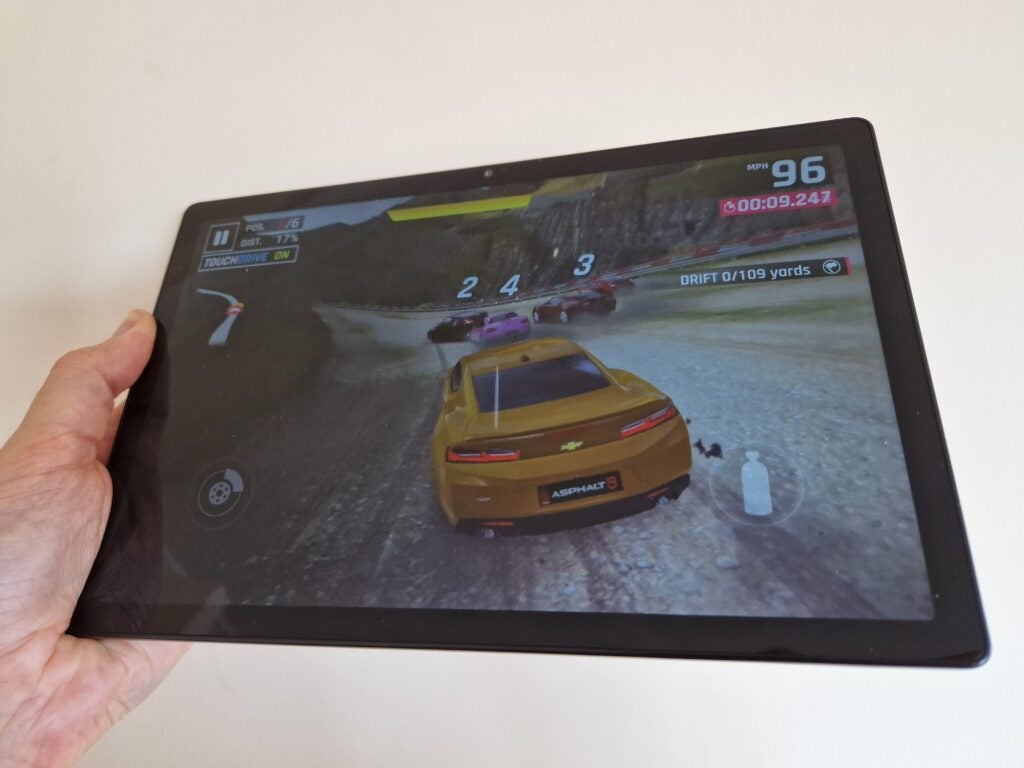
What’s more, these benchmarking tests aren’t just theory; in practice, the tablet often struggles to perform. Demanding games are a no-go.
There’s juddering lag when you’re playing racing games like Asphalt 9 that is highly distracting, and if you happen to have other apps running in the background at the same time then the hitches make the game nigh-on unplayable. This shortcoming is quite a shame, because playing racing or action games on a tablet should feel like a fun and immersive experience.
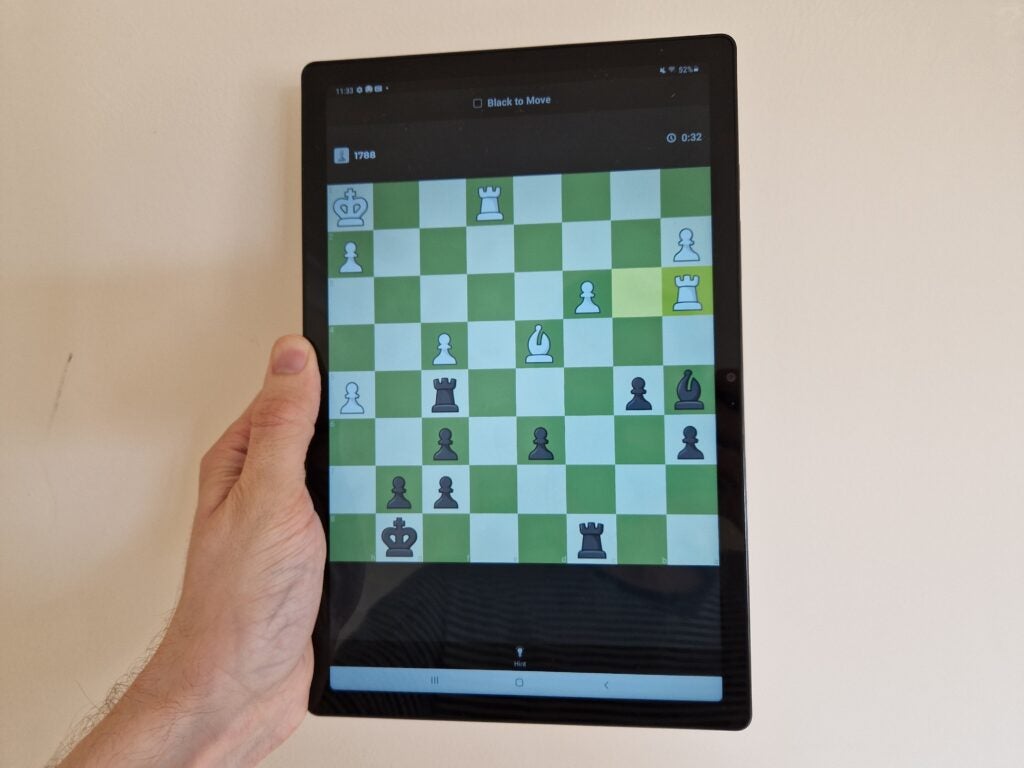
When playing light games, such as online chess, I didn’t notice any problems at all, and once again the form factor of a larger screen greatly enhanced my enjoyment; puzzle games can be a bit of a fiddle even on large-screen smartphones, but the size here was just right and gave me a similar feeling to playing a physical tabletop game. I also never noticed problems with lag or freezing when using the interface of streaming apps such as Netflix or MUBI.
However, when flicking between apps, there was noticeable lag and even a couple of times when the screen just froze for a few seconds. Closing one app and entering another sometimes necessitated a pause and on occasion the screen would register that you’d touched a different app. Even searching the device’s own Settings menu took an age. Using the camera app became torturous because it was so juddery. If you’re planning to use your tablet for anything more than light web browsing, simple apps, and video playback, then you should buy one with a bit more muscle, such as the iPad 9 or its successor.
Another concern was that I noticed that my Wi-Fi connection occasionally dropped out on this tablet while concurrently remaining strong on my smartphone and laptop. The variant we tested was Wi-Fi only, lacking mobile connectivity, and so any outage was very frustrating.
As for this device’s software, it runs Android 11. This is not the best software system for Android, since apps are often poorly optimised for the larger-screen experience on tablets, and tend to make poor use of the extra available space. However, it does at least grant you access to all the many apps on the Play Store, including your favourite social media apps, streaming services, and mobile games.
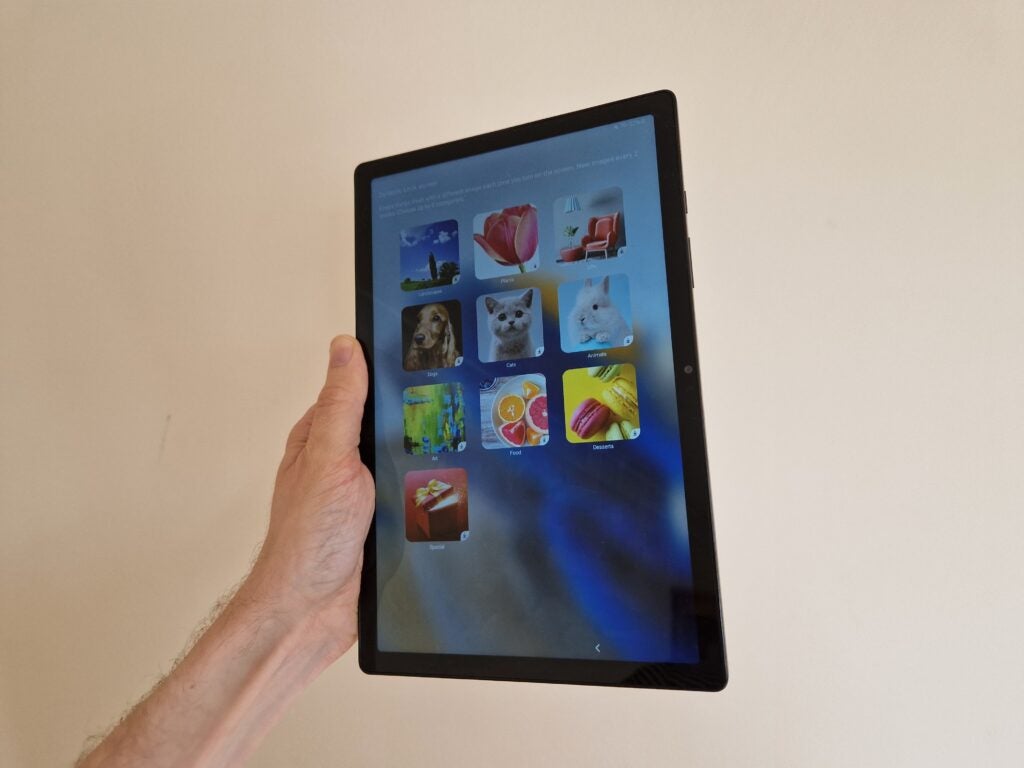
There are few frills that come with Samsung’s One UI overlay either, aside from the addition of a few extra apps on start-up, like the Galaxy Store, Samsung Notes, and other proprietary programs. One touch that I did particularly like was the option for dynamic lock screens. Simply swipe left on the lock screen and you’ll be given a menu of image libraries from which you can choose a theme (shown above). Then, every time you start up the tablet there will be a different picture to greet you. This looks especially good on the Tab A8’s 10.2-inch screen, and can help unexpectedly brighten up your day.
Battery Life
- Good battery life
- Slow charging speeds
Battery life is one of this tablet’s key strengths, and that’s especially great news when you’re taking on a long-distance trip such as a cross-country coach trip or a long-haul flight.
I did the latter, a nine hour transatlantic flight, and over the course of that long sleepless journey I watched three hour-long documentary episodes and two full-length feature films. Afterwards the battery was still on 60%, having started the trip at its full complement. It’s highly reassuring to know that you can count on this device for endurance.
To break down its battery performance into more specific examples, I found that one hour of streaming Netflix took the battery down by 6%, and half an hour of light gaming took it down by 3%. The only element where it struggled, and this likely won’t surprise you given how it performed, was intensive gaming; half an hour knocked 8% off the battery, giving another reason to avoid playing demanding video games on this platform.
I was also relieved to see that the Galaxy Tab A8 did not significantly discharge overnight, losing just 2% of battery after around nine hours on standby.
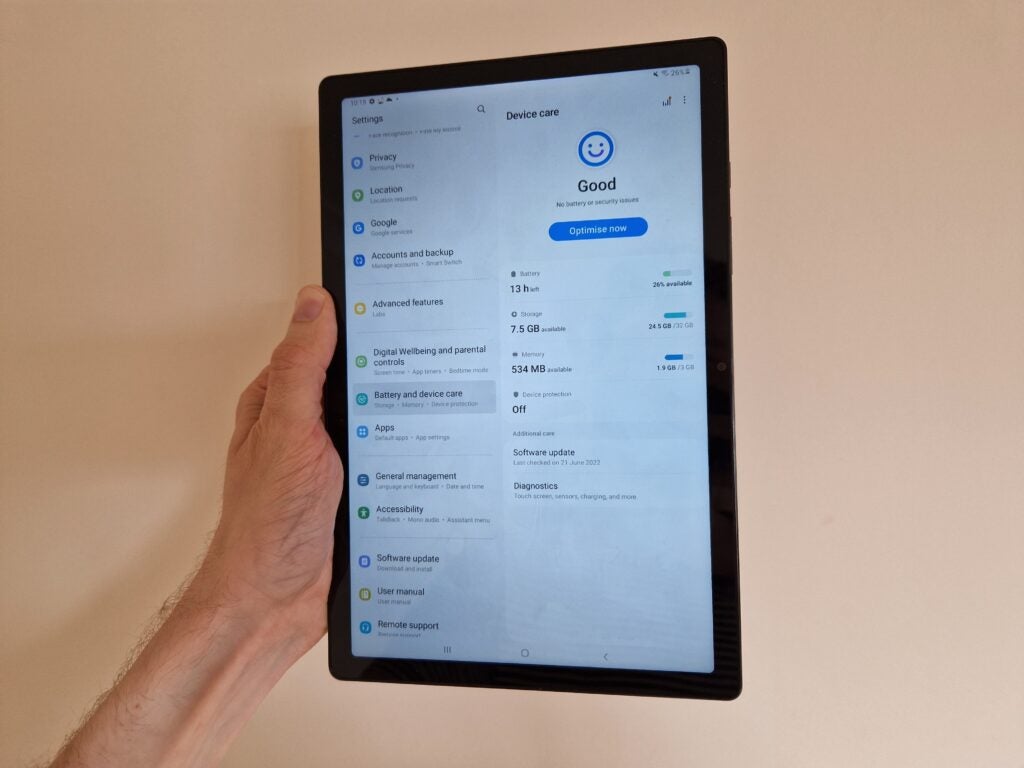
However, the flipside to this good battery life is that recharging does take quite some time – about one hour and forty minutes from empty to full, with this tablet’s 15W power equipped.
This means that if you suddenly realise that you’ve forgotten to charge your tablet before a trip, then frantically plugging in before your departure is unlikely to do much good, and you’ll only get about 5% of charge every ten minutes. Generally speaking tablets do lack the fast-charging chops of smartphones, so this device is far from the only offender, but it still could be a potential frustration. Naturally, there’s no wireless charging option either.
Camera
- Lacklustre camera quality
Your tablet’s camera quality may not have even been a ping on your radar in previous years, given that most people rely on their smartphones for taking snaps. However, since the pandemic we’ve seen a dramatic rise in video calling, and tablets can often be the most convenient device to use for this function.
We still don’t expect tablets to meet the high standards of modern smartphone photography, but they should at least be usable.

The above picture was taken by the 5-megapixel selfie camera, the snapper you’re most likely to use regularly on your tablet, and it’s grainy and washed-out; this effect is even worse in video mode, where harsher light sources can completely flood the lens, making it harder to see your face.
You will be able to hold a video call on this device, and it may even be better than your laptop’s webcam (though that says more about the computer than the tablet), but the quality is still weak and certainly won’t get you looking your best when you’re talking on Skype or on Zoom. If you’re thinking of using the video call function in a professional setting, rather than just calling family and friends for a chat, then I’d particularly recommend you take a look at higher-end tablets, especially the iPad or the iPad Air.
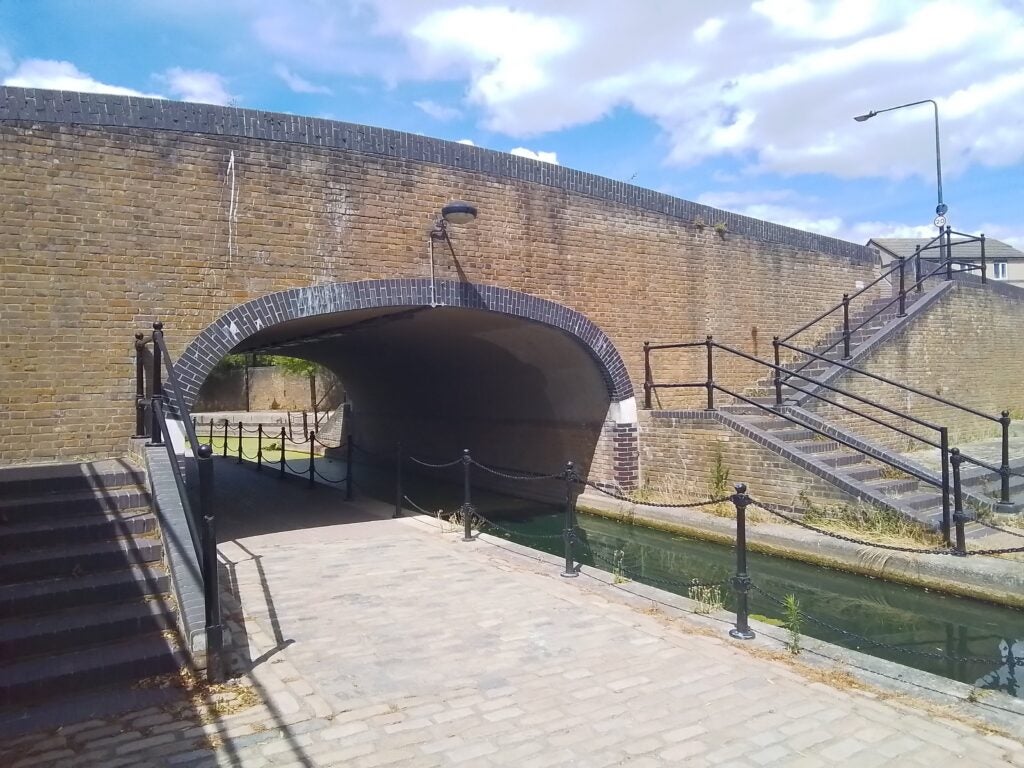
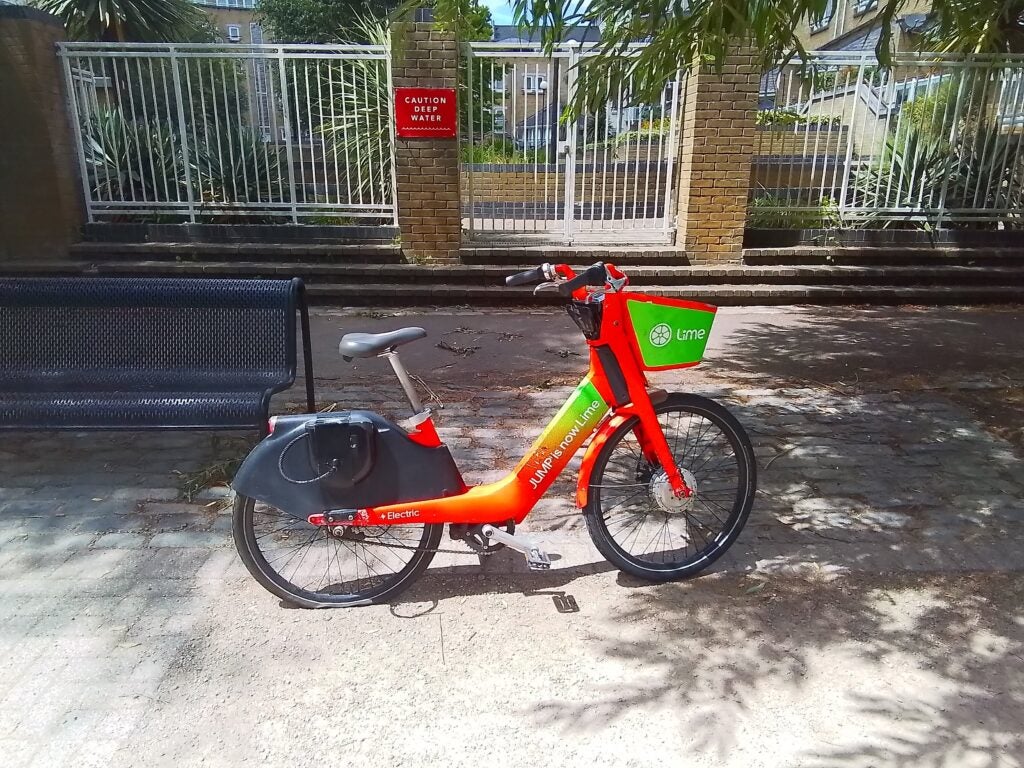
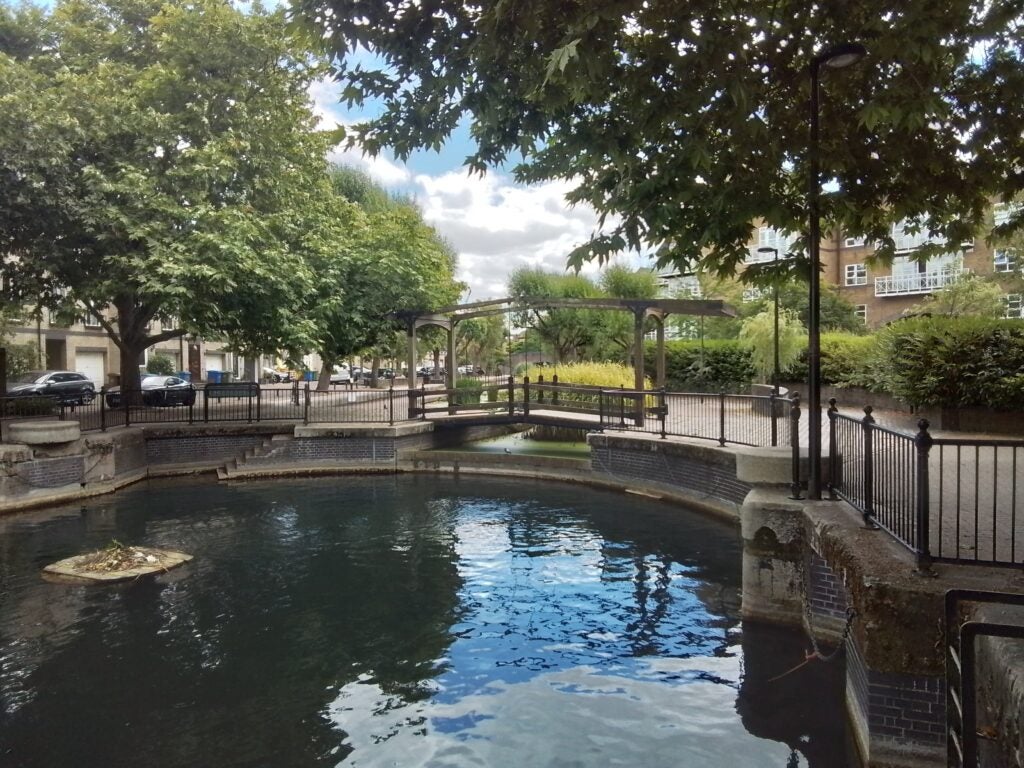
As for the rear camera, I’d expect that you’d only use this in a tight pinch if you found yourself temporarily away from your smartphone or camera, so its performance does not greatly affect my assessment of this tablet. The pictures above were taken with the 8-megapixel rear camera, and they’re nothing special – but if you just wanted to make a visual note of something for future reference or to share quickly with friends, then it will do the job.
Should you buy it?
If you’re looking for an affordable tablet to watch videos on and complete basic tasks then this one’s not bad, with the battery life being a particular highlight.
If you want to play games or use other demanding apps on your tablet – and if you’d look at your best on video calls – then you should avoid it.
Final Thoughts
The Galaxy Tab A8 is by no means a tour de force of a tablet, and its miserable performance standard is a particularly disappointing low note. It also won’t be the best for video calls, given the underwhelming font-facing camera, and it takes quite a long time to charge back up.
However, if you’re just looking for a modestly-priced travel companion to watch videos on, or use simple apps, then you could do far worse than this one; the screen is still good enough quality to enjoy films and TV shows, and the battery life offers impressive endurance that will comfortably see you through long-distance voyages.
FAQs
There’s no official IP rating, so we’re not sure how it would react if exposed to water or dust
The Galaxy Tab A8 has a 10.2-inch screen
It runs on Android 11 software
Jargon buster
IP rating
An abbreviation for ‘Ingress Protection Code’, which lets you know to what extent a device might be waterproof or dustproof.
OLED
Organic Light Emitting Diode is panel technology that allows each individual pixel to produce light rather than relying on a backlight. This enables the screen to accurately display blacks by turning off the pixel, resulting in improved contrast compared to conventional LCD panels.
LCD
The type of display usually used on cheaper and mid-range devices. Lacks the punch on an OLED panel.

